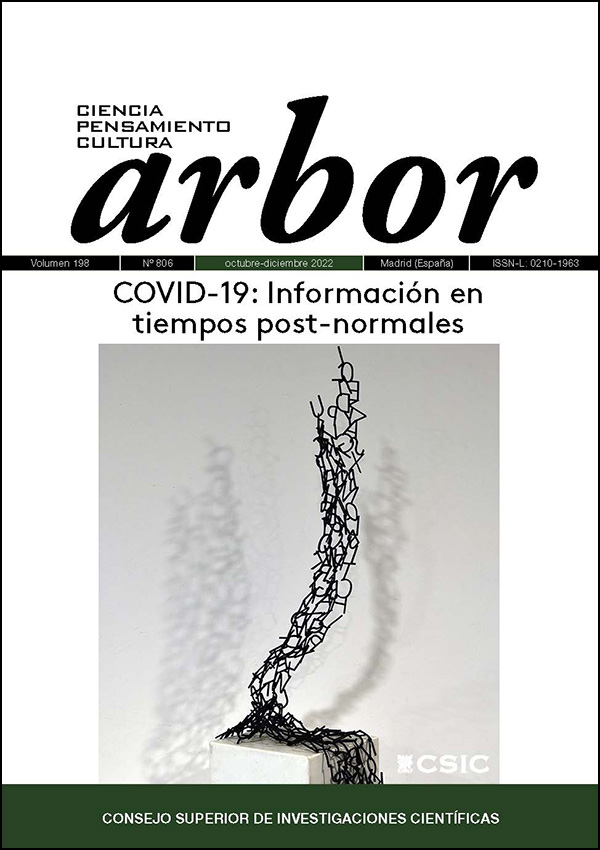Pandemic and infodemic: disinformation in post-normal times
DOI:
https://doi.org/10.3989/arbor.2022.806001Downloads
References
Aghababaeian, Hamidreza, Hamdanieha, Lara y Ostadtaghizadeha Abbas (2020). Alcohol intake in an attempt to fight COVID-19: A medical myth in Iran. Alcohol, 88, 29-32. https://doi.org/10.1016/j.alcohol.2020.07.006 PMid:32693023 PMCid:PMC7368655
Ajzen, Icek (2012). The theory of planned behavior. En Paul A.M. Lange, Arie W. Kruglanski y E.Tory Higgins (eds.) Handbook of Theories of Social Psychology (pp. 438-459). London: SAGE. https://doi.org/10.4135/9781446249215.n22
Bauer, Martin W.; Allum, Nick y Miller, Steve (2007). What can we learn from 25 years of PUS survey research? Liberating and expanding the agenda. Public Understanding of Science, 16, 79-95. https://doi.org/10.1177/0963662506071287
Bauer, Martin, W.; Pangsegrau, Petra y Shukla, Rajesh (2019). The Cultural Authority of Science. Comparing across Europe, Asia, Africa and the Americas. Routledge. https://doi.org/10.4324/9781315163284
Bucchi, Massimiano (2008). Of deficits, deviations and dialogues. Theories of public communication of science. En Massimiano Bucchi y Brian Trench (eds.), Handbook of Public Communication of Science and Technology (pp.57-76). London-New York: Routledge.
Comisión Europea (2000). Commission adopts Communication on Precautionary Principle. IP/00/96. Bruselas, 2 de febrero de 2000. https://ec.europa.eu/commission/presscorner/detail/en/IP_00_96
Cialdini, Robert B. (1984). Influence: The Psychology of Persuasion. Nueva York: William Morroy e Company.
Cinelli, Mateo; Morales, Gianmarco de Francisci; Galeazzi, Alessandro; Quattrociocchi, Walter y Starnini, Michele (2021). The echo chamber effect on social media. PNAS, 111 (9). https://doi.org/10.1073/pnas.2023301118 PMid:33622786 PMCid:PMC7936330
Echeverría, Javier y Almendros, Lola (2020). Tecnopersonas. Cómo las tecnologías nos transforman. España: Trea.
Funtowicz, Silvio e Hidalgo, Cecilia (2021). Pandemia posnormal: las múltiples voces del conocimiento. Papeles de relaciones ecosociales y cambio global¸154, 109-122.
Funtowicz, Silvio y Ravetz, Jerome (1993). Science for the post-normal age. Futures, 31(7), 735-755. https://doi.org/10.1016/0016-3287(93)90022-L
Functowicz, Silvio, y Strand, Roger (2007). De la demostración experta al diálogo participativo. Revista CTS, 8(3), 97-113.
Godin, Benoit y Gingras, Yves (2000). What is scientific and technological culture and how is it measured? A multidimensional model. Public Understanding of Science, 9, 43-58. https://doi.org/10.1088/0963-6625/9/1/303
Gould, George Milbry y Pyle, Walter Lytle (1896). Anomalies and Curiosities of Medicine. Blacksleet River.. Proyecto Gutenberg. https://www.gutenberg.org/ebooks/747
Kahan, Dan M. (2012a). On the sources of Ordinary Science Knowledge and extraordinary Science Ignorance. En Kathleen H. Jamieson, Dan M. Kahan y Dietram A. Scheufele (eds.), (pp. 34-49) The Oxford Handbook of the Science on Science Communication. London-New York: Oxford University Press.
Kahan Dan M. (2012b). Cultural Cognition as a Conception of the Cultural Theory of Risk. En Sabine Roeser, Rafaela Hillerbrand, Per Sandin y Martin Peterson M (eds.), (pp. 725-759) Handbook of Risk Theory. Springer: Dordrecht. https://doi.org/10.1007/978-94-007-1433-5_28
Kahan, Dan M. (2017). Ordinary science intelligence': a science-comprehension measure for study of risk and science communication, with notes on evolution and climate change. Journal of Risk Research, 20(8), 995-1016. https://doi.org/10.1080/13669877.2016.1148067
Kahan, Dan M.; Peters, Ellen; Wittlin, Maggie; Slovic, Paul; Larrimore, Lisa; Braman, Donald y Mandel, Gregory (2012). The polarizing impact of science literacy and numeracy on perceived climate change risks. Nature Climate Change, 2, 732-735. https://doi.org/10.1038/nclimate1547
Kuhn, Thomas S. (1962). The Structure of Scientific Revolution. EEUU: University of Chicago Press.
López Cerezo, José Antonio (2018). La confianza en la sociedad del riesgo. Barcelona: Sello Editorial.
Miller, Jon D. (1983). Scientific Literacy: A Conceptual and Empirical Review. Daedalus, 112(2), 29-48. https://www.jstor.org/stable/pdf/20024852
Miller, Jon D. (1998). The measurement of civic scientific lireacy. Public Understanding of Science, 1(3), 203-223. https://doi.org/10.1088/0963-6625/7/3/001
Nickerson, Raymond S. (1998). Confirmation bias: A ubiquitous phenomenon in many guises. Review of General Psychology, 2(2), 175-220. https://doi.org/10.1037/1089-2680.2.2.175
Noelle-Neumann, Elisabeth (1974). The Spiral of Silence A Theory of Public Opinion. Journal of Communication, 24(2), 43-51. https://doi.org/10.1111/j.1460-2466.1974.tb00367.x
OMS, (2013). Pandemic Influenza Risk Management WHO Interim Guidance. World Health Organization. https://www.who.int/influenza/preparedness/pandemic/GIP_PandemicInfluenzaRiskManagementInterimGuidance_Jun2013.pdf.
Plous, Scott (1993). The psychology of judgment and decision making. EEUU: McGraw-Hill. https://doi.org/10.1037/e412982005-012
Scheufele, Dietram, A. y Moy, Patricia (2000). Twenty-five years of the spiral of silence: A conceptual review and empirical outlook. International Journal of Public Opinion Research, 12(1), 3-28. https://doi.org/10.1093/ijpor/12.1.3
Published
How to Cite
Issue
Section
License
Copyright (c) 2023 Consejo Superior de Investigaciones Científicas (CSIC)

This work is licensed under a Creative Commons Attribution 4.0 International License.
© CSIC. Manuscripts published in both the printed and online versions of this Journal are the property of Consejo Superior de Investigaciones Científicas, and quoting this source is a requirement for any partial or full reproduction.
All contents of this electronic edition, except where otherwise noted, are distributed under a “Creative Commons Attribution 4.0 International” (CC BY 4.0) License. You may read the basic information and the legal text of the license. The indication of the CC BY 4.0 License must be expressly stated in this way when necessary.
Self-archiving in repositories, personal webpages or similar, of any version other than the published by the Editor, is not allowed.














